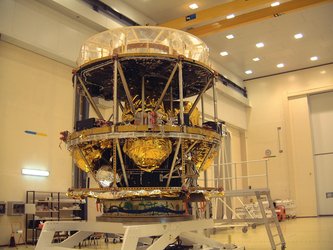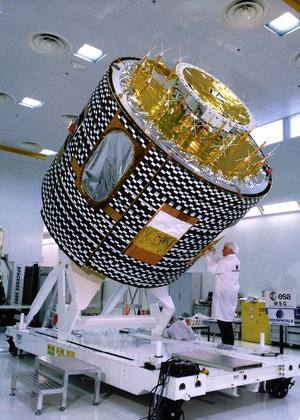MSG Launch Diary - week 5
15 June 2002
Work had been planned to exchange some cells on the MSG-1's solar array. However, another thorough inspection shows that this is not needed. Everybody's weekend is saved.
12-14 June 2002

Reconditioning of the battery is completed (two charges and two discharges), and the required values are fully within specifications.
In parallel, some validations are conducted after disconnection of the test harness, and on the Unified Propulsion System (UPS) launch electrical configuration. (During launch, not all on-board equipment is switched on to conserve battery life.)
The UPS is the spacecraft's propulsion system. Its components include:
- two Liquid Apogee Motors (LAM)
- six Reaction Control Thrusters (RCT)
- four propellant tanks
- two latch valves
- three pressure transducers
- four gauging sensors
The test harness is a cable to connect the satellite to different computers for various tests and verifications.
11 June 2002

Finally, the problem with the GERB is figured out, and the decision is made to use it as is.
With that, the normal test sequence is resumed. The SEVIRI flight configuration is activated, and no problems are detected.
In parallel, the preparation for the battery reconditioning and the solar array panels start.
10 June 2002
We are still investigating the GERB problem, but the situation is slowly becoming clearer.















 Germany
Germany
 Austria
Austria
 Belgium
Belgium
 Denmark
Denmark
 Spain
Spain
 Estonia
Estonia
 Finland
Finland
 France
France
 Greece
Greece
 Hungary
Hungary
 Ireland
Ireland
 Italy
Italy
 Luxembourg
Luxembourg
 Norway
Norway
 The Netherlands
The Netherlands
 Poland
Poland
 Portugal
Portugal
 Czechia
Czechia
 Romania
Romania
 United Kingdom
United Kingdom
 Slovenia
Slovenia
 Sweden
Sweden
 Switzerland
Switzerland





























